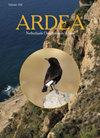Expanding East: Great Cormorants Phalacrocorax carbo Thriving in the Eastern Baltic and Gulf of Finland
IF 1.3
4区 生物学
Q3 ORNITHOLOGY
引用次数: 2
Abstract
Great Cormorants Phalacrocorax carbo in the eastern Baltic are expanding in numbers. Eight colonies in Estonia, Finland and the Russian Federation were investigated in 2007. Brood size and condition of large nestlings were determined and indicate that food provisioning was not a limiting factor. Food items consisted of both pelagic and benthic prey, with marked differences among the colonies. Eelpout Zoarces viviparus and Roach Rutilus rutilus were the most important prey according to fish mass. For pelagic prey this was Sprat Sprattus sprattus. Additional data in later years support the conclusion that the species experienced a rapid expansion at the time of investigation. Two factors are likely to have contributed to improved conditions for Cormorants in this part of the eastern Baltic. First, the low abundance of predatory fish such as Cod Gadus morhua and Pikeperch Sander lucioperca as a result of overfishing by commercial fisheries as well as climate change has, most likely, caused small benthic and pelagic prey fish to thrive. Second, increased eutrophication has probably fuelled the fish production. Based on fish species taken and the number of Cormorants present, the conclusion seems justified that any interaction between Cormorants and fisheries is unlikely at the scale of the Finnish Gulf, although locally measurable effects of Cormorant consumption on commercial yield may exist. As a visible, relatively new apex predator to the system, the Great Cormorant may well be an indicator of the ecological condition of the system. Monitoring of Cormorants (numbers, distribution, food, breeding success) may therefore provide useful data which can be used to assess the recovery of the benthic and pelagic parts of the food web.向东扩张:大Cormorants Phalacrocorax carbo在波罗的海东部和芬兰湾蓬勃发展
波罗的海东部的Phalacrocorax carbo大Cormorants数量正在增加。2007年对爱沙尼亚、芬兰和俄罗斯联邦的八个殖民地进行了调查。确定了大型雏鸟的繁殖规模和状况,表明食物供应不是一个限制因素。食物包括上层和海底猎物,各殖民地之间存在显著差异。根据鱼类数量,黄鳝和Roach Rutilus Rutilus是最重要的猎物。对于远洋猎物,这是Sprat Sprattus Sprattus。后来几年的额外数据支持了这样一个结论,即该物种在调查时经历了快速扩张。有两个因素可能有助于改善波罗的海东部这一地区的珊瑚礁状况。首先,由于商业渔业的过度捕捞以及气候变化,Cod Gadus morhua和Pikepers Sander lucioperca等掠食性鱼类的丰度较低,很可能导致小型底栖和中上层掠食性鱼类茁壮成长。其次,富营养化加剧可能助长了鱼类生产。根据所采集的鱼类种类和存在的Cormorant数量,得出的结论似乎是合理的,即在芬兰湾的规模上,Cormorant与渔业之间不太可能发生任何互动,尽管当地可能存在Cormorant消费对商业产量的可测量影响。作为该系统中一种可见的、相对较新的顶级捕食者,大Cormorant很可能是该系统生态状况的指标。因此,对Cormorants的监测(数量、分布、食物、繁殖成功率)可以提供有用的数据,用于评估食物网中底栖和中上层部分的恢复情况。
本文章由计算机程序翻译,如有差异,请以英文原文为准。
求助全文
约1分钟内获得全文
求助全文
来源期刊

Ardea
生物-鸟类学
CiteScore
2.10
自引率
0.00%
发文量
49
审稿时长
>12 weeks
期刊介绍:
Ardea is the scientific journal of the Netherlands Ornithologists'' Union, and is published since 1912. The journal welcomes manuscripts reporting significant new findings in ornithology, in particular those covering the ecology, life history, and evolution of birds, and including sound descriptive work. Ardea publishes Original research papers, Short notes and Book reviews. In addition to the regular three issues per year, Ardea publishes specials that contain conference or workshop proceedings (produced on request).
 求助内容:
求助内容: 应助结果提醒方式:
应助结果提醒方式:


